Do-it-yourself horizontal drilling: a sequence of actions. Description of horizontal directional drilling technology.
To lay a pipeline, it is often required to perform a so-called puncture under the road. Perform it with various methods of horizontal directional drilling (manual or using special HDD installations).
The technology is quite simple, and you can make a puncture yourself. How economically feasible is, consider below.
Horizontal soil drilling refers to the methods of trenchless channel formation for laying communications. This allows you to use it in cases where the destruction of the soil surface is impossible, for example, if pipes or cable must be laid under the road.
The HDD method of drilling is selected depending on the specific conditions at the facility. There are three methods:
- Do-it-yourself drilling using a chipper and a large hammer drill;
- Drilling using a mini HDD installation;
- Industrial drilling with high power installations.
In order to lay the communications of the drainage system in the suburban area, usually manual methods or mini-installations are used. With their help, it is possible to puncture the soil under the road without extra time and money.
Do-it-yourself horizontal drilling
The most economical way to puncture the soil for laying communications, if you have the appropriate equipment, of course. It is carried out using a special bailer and a large hammer drill. Technically, such a GNB puncture is very simple.
The main element is a bailer made of a large hydraulic cylinder. To facilitate drilling, a crown with sharpened petals is made at the end of the sleeve. Its diameter is slightly larger than that of the cylinder, since this makes it easier to pull out the return (selected soil) during drilling.
A large hammer drill is used to push the crown. The sleeve with the crown is pushed in the right direction, the return is periodically removed from the puncture, and the bailer is lubricated with water to facilitate drilling. As it progresses, the crown builds up by welding.
Manual drilling allows you to successfully deal with a puncture in most cases. Although sometimes using this method is impractical. For example, many roads in the Moscow Region were built using a large amount of bulk soil, which can contain a large number of stones and various construction debris that impede the normal passage of the crown. In this case, you need to perform work using special installations - mini HDD.
Drilling by installation of mini HDD
Mini installation horizontal drilling refers to pit type equipment. It differs in small size and ease of operation. Designed for drilling and expansion of wells for laying communications.
Depending on the model, the mini-installation is able to provide pressure up to 20 tons, so it can easily cope with stretching pipes of various diameters. Mini HDD are perfect for work in settlements, densely populated areas of the city, in a confined space.
The drilling process is very simple. The equipment is installed and assembled in a pre-dug pit 1.5 × 2 meters. The depth of the pit depends on the hydrogeological features of the site, the design of the engineering network.
The launched mini-installation creates pressure, under the influence of which the rods are pushed in the right direction. If necessary, drilling fluid is supplied to the mine.
Control over the correct direction is carried out using navigation equipment. After completion of work, the drill leaves on the other side of the road. A corrugated hose or pipe of the desired diameter is attached to it, the entire structure extends in the opposite direction.
HDD installations for industrial drilling
Industrial plants are designed for drilling and expansion of wells. They provide the implementation of underground passages over significant distances. The direction of movement of the crown is regulated by a flexible cable fixed on one side to the end of the drill rod. The second end of the cable is controlled by the operator. During sinking, drilling fluid is supplied to the mine.
For the laying of local sewer systems, industrial HDDs are not used. In addition to the fact that it is not economically feasible, the dense development and limited space also cause complexity.
As a result, the costs will amount to at least 50 thousand rubles (excluding the manufacture of the baffle and the cost of the pipes) - the difference is obvious.
Independent manual drilling will require much higher costs than the involvement of specialists.
We will not discount the time spent on work. Where masters can cope in a few hours, a layman can spend more than one day.
As you can see, independent drilling in any case leads to very large unjustified costs. To avoid unnecessary time and money, it’s more logical to order the turnkey installation of an autonomous sewer installation service.
Video: puncture under an expensive mini HDD installation
Specialists of installation teams perform such work almost daily, starting with the installation of a septic tank and ending with the laying of communications, often including horizontal drilling of the soil.
Comments:
Drilling a horizontal well with your own hands is quite difficult, but it is quite possible if you are in good physical shape.
For horizontal drilling, you will need the following materials and tools:
- metal pipes having the required diameter, their length should be 10 cm longer than the width of the road;
- welding machine;
- bulgarian;
- pump equipped with a hose;
- hand drill for horizontal directional drilling;
- sledgehammer;
- funnel on which the hose is put on (2 m);
- barrel (200 l) - it is better if the container is made of steel or plastic.
Horizontal drilling process
In order to do the horizontal directional drilling with your own hands correctly, it is very important to observe the basic conditions of the technology. The whole process of work is carried out in several stages.
Digging pits
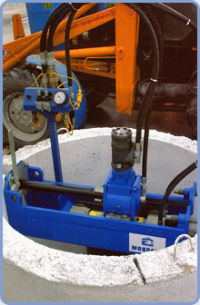
First of all, from two sides of the road it is necessary to dig 2 pits with a depth equal to the pipe to be installed. In addition, so that the horizontal drilling process does not cause unnecessary inconvenience in the future, it is recommended to leave another 20 cm.
Since the pits will be the main place of work, it is worth making sure that they continue the trench. As for the length that they should have, it should be equal to the minimum length of pipe. To install the pipe you will need a sledgehammer. The receiving pit should be sized to fit in it so that horizontal drilling is convenient.
Horizontal directional drilling: pipe installation
The next stage of horizontal drilling involves marking the axis of the pipe. To do this, the pipe should be sharpened so that it looks like peaks, the Bulgarian will help. So the pipe will easily enter the ground. It is necessary to hammer in the prepared pipe so that it represents an axis. In order to prevent the sledgehammer from bending a pipe segment, its maximum size should be 2 m. Each driven piece is welded by a welding machine. The steel bar that appears from the pit will be the guide. On it the installation of the pipe itself is performed. By acting in this way, it will be possible to avoid damage if a stone or brick is caught during the passage.
Pump operation
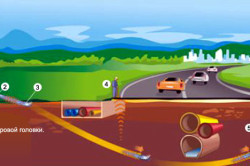
Having dealt with the previous stage of horizontal directional drilling, you should proceed to installing the pipe segment on the rod, which plays the guiding role. Next, using a piece of large-diameter pipe, make a removable nozzle-cup, known as the “heel”. Clogged pipes will not flatten with this element.
In the area of \u200b\u200bfuture impacts, the heel is fixed on the pipe, after striking it is removed. Next, you need to use a pump equipped with a hose that pushes along the pipe until it stops. After that, the pump should be turned on. Many experts prefer to use a plastic pipe (12 mm) for this purpose. Using a blowtorch, it is straightened in advance.
You can increase the pressure of the water flow coming out of the hose or pipe by putting a sleeve over them. This will achieve a narrowing of its diameter. To prevent water from spreading along with the soil, dig a hole under the hose. In the barrel, the turbidity is collected using a funnel with a hose on it.
The funnel can be replaced with a 5-liter plastic bottle, having cut the bottom in advance. The pump is rearranged into a barrel filled with a little more than half. The filter can be made from a narrow plastic bucket with drilled small holes.
The final stage of horizontal drilling
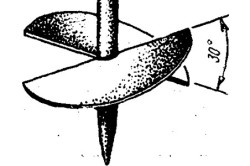
The line after line is welded until it appears from the pit located on the other side of the road.
DIY drilling technology consists of the above steps. Work requires the use of physical force. In addition, be prepared for the fact that without a large margin of patience can not do here.
Horizontal Drilling Rig
The use of horizontal directional drilling when installing a pipeline is far from new. As for work on a large scale, rarely without a professional drilling rig. Using a manual drilling rig, it is possible to successfully perform, for example, suburban construction.
Do-it-yourself drilling saves a significant amount of money. The main thing at the same time is not to forget that it is necessary to install special equipment in accordance with all technologies and standards.
Working with a rig requires consideration of all the rules, so before you do the drilling yourself, it is very important to carefully study the instructions.
How to make a drilling rig do it yourself?
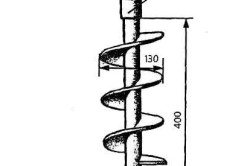
You can easily purchase equipment of any kind in any specialized store. Such an instrument is not cheap, so it makes sense to do it yourself. In order to make a drilling rig, with the help of which it will be possible to independently perform horizontal directional drilling, such materials and tools will be required:
- 2 pieces of pipes, the inner diameter of which is 4-5 cm, their length should be equal to 12 cm.
- A pipe segment having a length equal to the desired well and a diameter of 3-4 cm.
- Sheet steel 4 mm thick.
- Apparatus for electric welding.
- Blowtorch.
- Scissors for working with metal.
The main stages of manufacturing a manual drill:
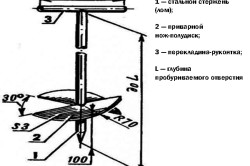
- Using sheet steel, a circle should be cut corresponding to the optimal diameter of the wells.
- A hole is cut out in a circle so that its diameter coincides with the pipe. If you could not cope with this task with the help of a grinder, try using a welding machine.
- Next, proceed to cutting the segment from the resulting ring. The segment should have a span approximately coinciding with the stones contained in the ground. So that when performing horizontal directional drilling, one does not have to face any difficulties, it is necessary to choose the best option. The fact is that horizontal drilling using equipment that has a very large segment will take you a lot of time, and if the size of the stones exceeds it, it simply will not hook them.
- Armed with a hammer, make a spiral out of the ring, then sharpen its cutting part.
- The next step is to start making the tip. To do this, the steel strip must be clamped in a vice. Next, using a blowtorch, you need to heat it as much as possible. The strip is screwed. The screwed part is cut to obtain a suitable length, after which it is given the intended shape.
- Next, proceed to welding the tip to the main pipe. To do this, it must be placed in a transverse neckline.
- Having screwed the ring into the screw, it should be welded. Its location should slightly exceed the connection of the pipe with the tip. To insert the handles 2 pipes are welded to the pipe.
- Finally, handles are inserted into the structure, after which horizontal drilling can be performed using it.
Before horizontal drilling, a thorough design is required. Determine how deep the communications are. By doing so, you will avoid various problems. Only by making an approximate plan, according to which horizontally directed drilling will be carried out, can we proceed to the subsequent stages of work.
Inclined-horizontal drilling is a technology for drilling wells whose spatial position deviates from a vertical line in any direction, up to a full horizontal location. Wells considered to be inclined are those that deviate from the vertical by more than 2 degrees.
Directional drilling is performed using a special design of the drill rod and head with a flexible connection, which allows you to change the direction of movement of the drill inside the soil during operation.
1 Purpose and advantage of HDD technology
In industry, inclined well drilling is in demand in the oil and gas sector, in construction, and the method is also widely used to create underground utilities.
Directional drilling is used to perform the following tasks:
- Creating wells for oil and gas;
- Drilling for mining;
- Laying of water supply and sewage pipes;
- Laying of gas supply communications;
- Installation of oil pipelines and gas pipelines;
- Arrangement of cable lines.
Today, directional drilling is the most economical way to create underground utilities and perform any underground work. Compared to digging trenches with your own hands, directional drilling has the following advantages:
- Minimization of time and financial costs.
- The possibility of laying communications without destroying the asphalt surface.
- Drilling of wells (both normal and mini - to a shallow depth) can be carried out under water bodies, transport routes and in places where ground-based construction work is prohibited.
- Work can be carried out by a mini-team of 3-5 people.
2 Equipment used for HDD
Equipment for horizontal drilling can be divided into several types: a machine for HDD, a location system for HDD, auxiliary devices - swivels, staples, clamps.
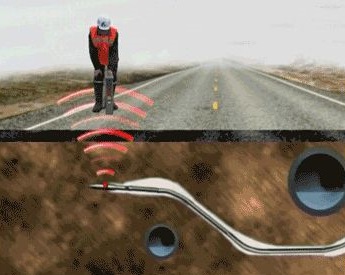
Location system for HDD. Without the presence of such a system, it is impossible to fully control directional drilling, since during operation the drill is out of sight.
So that drilling does not lead to unpredictable consequences (destruction of the existing communications, equipment breakdown due to underground barriers), and in order to fully control the accuracy of well drilling, a special geolocation system is used.
Such a device consists of two main parts: a mini probe, which is installed on the drill head, and an apparatus for tracking its performance. When directional drilling is carried out, this system is controlled by an operator who reads all the information coming from the mini-probe, and on its basis corrects the drilling process.
The use of a mini probe is an indispensable part of the HDD process.
Drilling machine. Directional drilling is performed by expensive professional equipment. Industrial machines for HDD have frame designs: they consist of a body, a diesel engine, and a running gear. In turn, the functional part has the following elements: a drill carriage, a hydraulic station with a hose for supplying water, and a panel for controlling the process.
The classification of drilling rigs is carried out depending on the marginal pulling force, which is measured in tons. In addition, the key characteristics of any installation are the maximum possible diameter and length of drilling.
Secondary factors that you need to pay attention to when choosing a device for drilling a well and laying pipes are concrete flow rates (l / min), and the bending radius of the drill rods - it affects the ability to change the direction of drilling along the way.
You can also highlight the technology of horizontal auger drilling, which is performed using fairly simple drilling rigs, consisting of a drill head, rod, motor, and frame, which connects them into one mechanism.
In comparison with industrial drilling machines, this design has a mini size. In addition, it is quite simple to manage - after a short introductory course, drilling can be done by anyone yourself.

Auxiliary devices. This category includes all the fixing elements for laying PVC casing pipes, adapters, expanders, pumps for pumping out excess concrete, electric generators, lighting systems and emergency response tools.
2.1 Stages of HDD
Before you start drilling horizontal wells, you must perform the following preparatory work:
- The location of underground utilities, which are located within the area where the HDD will be implemented, is being specified. Places of existing communications - pipelines, cable lines, should be marked with identification marks.
- Based on the characteristics of the soil, and other important factors, the optimal route of laying is selected.
- A site is being prepared for the drilling rig (soil equation, creating lighting), and the access path to it.
- The drilling machine takes its initial position, the required amount of bentonite (solution to strengthen the well), and drill rods are delivered to the site.
A pilot well is being drilled (mini tunnel with a diameter of up to 100 mm). Initially, the drilling process of deviated and horizontal wells begins at an angle of 10-20 degrees, which, in the process of reaching a given depth, is adjusted to the desired indicators.
During HDD, a change in the movement of the drill is possible in all planes. The closer the drill head is to the exit point, the stronger the drill goes up, so that the well gets the required angle at the exit from the ground.
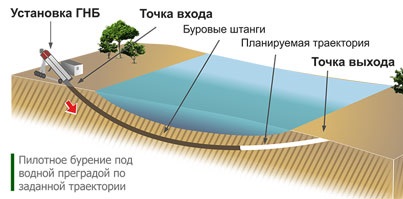
The technology of horizontal directional drilling requires the use of special devices for monitoring the process, which track the location of the drill underground, and make it possible to accurately determine the depth of its penetration into the soil.
In order to expand the well, the do-it-yourself drill head is replaced with a rimer (a special device for expansion), after which the reverse rotation mode is activated on the drilling machine and the reverse movement of the reamer is performed, in the direction from the well exit point to the drilling rig.
The number of passes required to perform the expansion of the well to the desired diameter can vary from 1 to 3. This depends on the characteristics of the soil and on which drilling device is used. If several penetrations are necessary for expansion, then the rimers are successively changed to larger diameter devices.
Pipe laying is carried out using a swivel system and brackets that are connected to the pipe, and perform the function of fasteners and clamps, with the help of which the pipes are pulled into the well.
To fix the pipes with a swivel, a special borehole head is mounted on its edge, to which the drill string is attached. In small-sized wells, the casing of which is carried out by polymer pipes with a small weight, gaskets can be done by oneself, otherwise the drilling machine makes an effort to tighten the pipes.
After the pipe is mounted properly, it is disconnected from the drill string, after which the HDD process can be considered complete.

When all stages of drilling of deviated and horizontal wells are completed, the drilling rig is rolled up and the site is cleaned.
The directional drilling method implies the need for mandatory use of concrete. Bentonite is a special solution that is used to strengthen the walls of the well, since the risk of soil collapse with HDD is quite large. Concrete also reduces the friction of the drill and improves the process of extracting the drilled soil out.
Bentonite largely determines the effectiveness of the entire drilling process, since a poor quality solution, which will not have the necessary flushing properties, will be the reason for the additional time required to clean the well from the soil.
Since a large amount of bentonite solution is used in the HDD process, surpluses may accumulate at the inlet and outlet of the well, which, after completion of drilling, must be removed with your own hands or pumped out using a pump. All concrete residues must be disposed of.
There are certain restrictions that prevent the use of HDD:
- Underground obstacles may cause the inability to continue HDD;
- The limited bending of the drill rods for HDD does not allow for short and shallow changes in the direction of the well (up to 5 m);
- Directional drilling cannot be carried out in monolithic rocks or in soils with a high concentration of boulders.
2.2 Description of HDD technology (video)
- Sequencing
- Additional measures
When working with the pipeline, it is often necessary to face the need to make a horizontal elongated stroke. Cases are different, but horizontal do-it-yourself drilling is often required when carrying out various works.
The procedure is quite complicated, and only a physically strong person can perform it.
Material selection and preparation
The choice of materials should be treated as carefully as possible. here in every step maximum reliability is required:

- The device for electric arc welding is suitable for medium or high power (inverters can be used, but their power is often not enough).
- A grinder with discs of 180 or 230 mm, and it is exclusively two-handed. The consumption of cutting material will be quite large, but you need to be prepared for this.
- Sledgehammer.
- The reinforcing rod is 25 mm or more, and its length must be 10-15 cm longer than the length of the hole being drilled.
- A steel pipe of the appropriate diameter, and along the length of the segments will be equal to the reinforcement.
- A pump with a hose and a 200 liter steel barrel with a wide mouth.
- Manual horizontal drill.
- Funnel with a 2 meter hose.
After the equipment is prepared and unloaded at the place of work, you need to dig 2 pits located at the places of entry and exit of the pipe. Their depth is 20 cm higher than necessary, because otherwise it will be quite problematic to work. The width is usually 60 cm, but if you have to work on a recess of more than 1 m, then it is better to expand to 0.8 m. Each of the pits will have a sufficiently large length (length of reinforcement), because otherwise there will be nowhere to place work tools.
Back to the table of contents
Sequencing
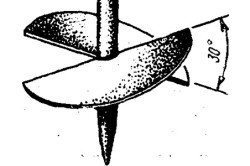
Using angle grinders, a reinforcement segment is sharpened up to 2 m, and sharpening should be uniform and maximum. When using a cut of more than 2 m, the risk of bending is high.
Now you can directly start horizontal directional drilling. This piece with a sledgehammer is driven into the ground in the right direction, and the blows should always be uniform.
After the segment is completely driven in, you need to weld the next one on it. Thus, work is progressing to the required depth. At the junction with the breed, you can slightly bend the rod, so you need to be careful. The work ends exactly at the moment when a working “head” appears at the exit point. In this way, a guide rod is formed.

Now a pipe of a larger diameter is taken and put on the reinforcement. One more small piece of a slightly larger diameter (glass) is put on top of the pipe, which will protect the pipe from flattening upon impact, and after no longer need to be beaten, the glass should be removed. The pipe must be sharpened with a grinder, so that the progress of work is maximum.
After the pipe is driven to the maximum (no more than 2 m), you need to install a pump with water in it and turn on the feed. To artificially increase the pressure, nozzles for reducing the diameter are used. Water will come out of the open part of the pipe, for which a 200 liter barrel was prepared.
When work with the segment is completed, you need to remove the barrel to the side and empty it. Now you can weld another section from above and continue the activity in the same way until the pipe exit on the other side is fixed. It is worth considering that one glass is used for all work.
Manual horizontal drilling requires a special tool, without which it is impossible to drill even a small well. In principle, among the types of such equipment: a drill, a mini installation and a machine for horizontal drilling.
Among the existing types of tools for horizontal drilling, the most optimal is a mini-installation for drilling horizontal wells. It is ideal for those involved and planning to expand their business in the future.
Although, even the owners of suburban homes can take advantage of such installations in order to drill a hole on their own site.
A mini installation for horizontal drilling allows you to drill wells up to 50 m deep. Practice shows that wells of this depth will be quite enough to provide a summer cottage with good quality water.
Mini horizontal drilling rig
Using this installation can significantly reduce the cost of the finished well. Moreover, the installation is transported on Gazelle vehicles, and it is easily installed manually at any place. The installation kit includes such tools for drilling wells:
- winch;
- gearbox;
- rods;
- swivel;
- electronic control unit;
- racks for the gearbox.
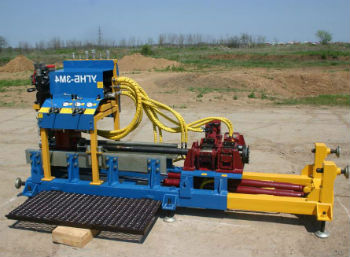
The basic set of mini installation will cost about 66,000 rubles.
Small-sized horizontal drilling rigs have a principle based on hydraulic drilling of a well using recycled water.
Water, which is supplied by special injection pumps, is fed into the well through drilling hoses and leaches the soil from it. True, if the soil is rocky, then this method of drilling will be unusable.
Of course, the presence of such an installation is the top of drilling skill in a manual way, and even core drilling of water wells is no match here. But what to do for those who do not have the funds for such installations?
 In this case, it is proposed to purchase a manual drill for horizontal drilling, with which you can independently perform horizontal drilling without the use of special equipment.
In this case, it is proposed to purchase a manual drill for horizontal drilling, with which you can independently perform horizontal drilling without the use of special equipment.
Despite the fact that the appearance of the BR-2 drill is not very presentable, with this simple tool you can perform a number of serious tasks in the field of individual construction.
A drill for horizontal drilling is convenient in that it can significantly increase labor productivity in the manual method of drilling horizontal and vertical wells.
The drill set includes a rod with a sharp tip in its lower part, a cutting unit, which is located above the tip.
The bar has an adjustable length. The use of this drill provides not only ease, but also the speed of drilling wells.
Earth drill for horizontal drilling has the following main advantages:
- it is very convenient to use such a drill in those places that are considered impassable for special machinery and equipment;
- even an unprepared person can use it;
- the cost of such a drill is much less than the cost of more serious equipment for independent drilling of wells and depends on the type of handle, the diameter of the nozzles and their number. Although the average price for such a drill will be, no less than 10-15 thousand rubles.
The machine performs sufficiently high precision drilling, does not require highly skilled workers and is easy to operate.



